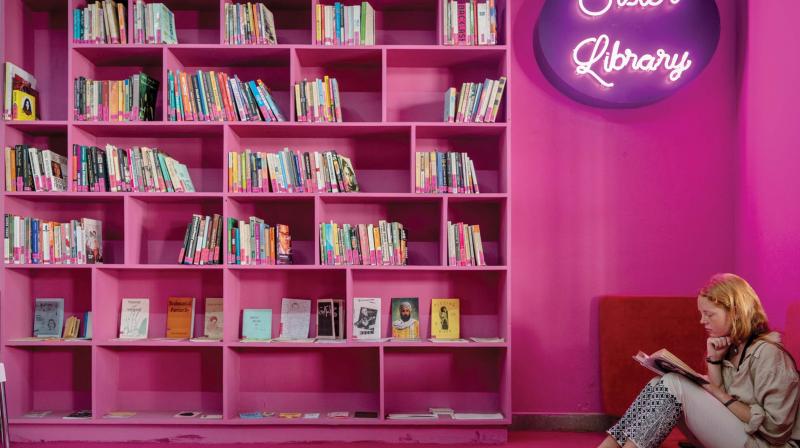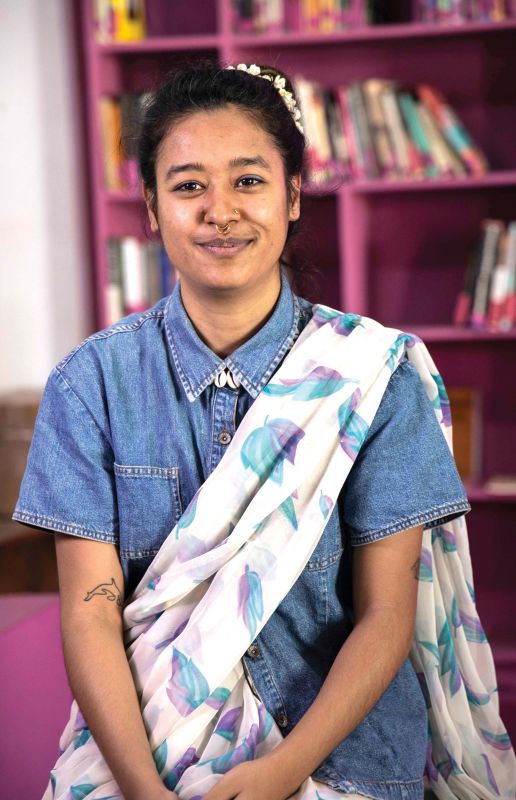Celebrating women's creativity
Thami's work reflects on the absence of safe community spaces that allow women to read works about other women.

The red-and-white-walled Pepper House sports a pinkish library at one corner these days. And there’s something particularly striking about its books: the authors are solely women. Most of the books deal with gender inequality across the world and caste hierarchy in India, with feminist perspectives that bear a historical approach as well. There are graphic novels as well as illustrated zines — those low-cost self-publications aiming a small circulation. They are by young artist-activist Aqui Thami.
Thami, 29, has been working on this moving library that is an infra-project under the ongoing Kochi-Muziris Biennale. ‘Sister Library’, as it is called, reflects on the general reading culture in the country even as it seeks to “celebrate the contributions of women in the creative world”.
The 100-book library, along with Thami, has so far travelled five cities: Goa, Delhi, Pune, Mumbai and Bengaluru. The sixth is Kochi. Starting this week at the sea-facing venue of Pepper House in Fort Kochi, she is leading a month-long workshop featuring feminism-centric reading sessions, film shows, talks, discussions and art workshops.
“‘Sister’ is a word of solidarity that brings together women from all classes, regions and languages,” explains Thami, who lives in Mumbai after having been brought up in West Bengal’s hilly Darjeeling.

Artist Anita Dube, who is curator of the 108-day biennale that began on December 12, notes that Sister Library aptly describes the festival’s two running themes: feminism and pedagogy. “Aqui has prioritised through her workshops and aesthetics that learning can be pleasurable and accessible. This is a major aim for me,” Dube notes.
According to Thami, the year-old project is still evolving. “The idea is to engage in an in-depth reflection on the visual and reading culture prevalent among women,” she says.
“The library will make people look at the works of women seriously. The readers can celebrate the ideas of women authors,” she says. “The perception of women will be widely shared. It will start help shift some of the general perceptions about women around and hopefully bring a change some day.”
The artist had visited the biennale during its previous (2016) chapter. She says she feels great to be part of the latest edition for the ongoing biennale has women forming more than half of the 90-plus artists. Hailing Anita Dube’s vision, Thami says the biennale has boosted artists like her, who belong to an indigenous culture and come from the global south.
Thami’s work reflects on the absence of safe community spaces that allow women to read works about other women.
“Works of women writers are not easily available. It took me years to have a collection of around 4,000 books. I come from the mountains that have an indigenous community; I have gone through so much intergenerational trauma. I face a lot of racism in the land. I went through a very dark age of my life where art became a ray of light and a healing element,” adds Thami, who received the 2017 Inlaks Fine Art Award for the project.
Some of the notable authors in her treasured collection include Sylvia Plath, Ursula le Guin Alison Bechdel, Naomi Wolf, Gloria Steinem, Susan Sontag, Bell Hooks, Simone de Beauvoir and Audre Lorde. Alongside them were displayed the works of Ishmat Chugtai, Imitiaz Dharker, Sharmila Rege, Taslima Nasrin, and Nayyirah Waheed, besides plenty of non-fictional works on intersectional feminist history.
Thami has been working in the Dharavi Art Room in Mumbai with its founder-educator Himanshu Shady since 2012, providing women and children in the community with a place to express and heal them through art.

